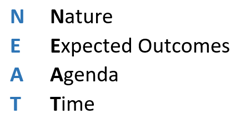Does your business have NEAT meetings?
It has been estimated that the average employee spends one quarter of their time in meetings. For executives , this estimate increases to three quarters. Further estimates suggest that more than half of these meetings are quite wasteful. As one of the tenets of LEAN is the elimination of waste, we should all be actively motivated to make our meetings not only more efficient but also more effective. Every meeting has a cost, at your next meeting count the number of people present and work out a rough average hourly rate to estimate the simple cost of the meeting – you may be surprised how large it can be. The best way to balance the cost is to ensure that the meetings have value.
Dick Lyles in an excellent article in 2007 How to Eliminate Meeting Madness first introduced me to the term NEAT meetings.
As the article explains, NEAT is an acronym that stands for :

The N stands for Nature. What’s the nature of the meeting? Is it problem solving? Decision making? Planning? It is important for participants to know the kind of meeting it will be, so they will appreciate the role they will be called upon to play in the meeting.
In his book, Death by Meeting, Patrick Lencioni describes four common types of meetings:
- Daily Check In = 5 - 10 mins to share daily schedule and activities
- Weekly Tactical = 45 - 90 minutes to review weekly activities and metrics and resolve obstacles & issues
- Monthly Strategic = 2- 4 hours To decide upon, discuss, brainstorm critical issues affecting long term success
- Quarterly Off Site = 1-2 days To review strategy, competitive landscape, industry trends, key personnel, team development.
You may have others but he stresses the importance of not confusing the purpose of each of these types. He also makes the analogy for the types of meetings - the Daily Check in is like the Newsflash with short crisp information given in bullet form, the Weekly tactical is like the weekly 1 hour TV drama series and the Monthly strategic is like a movie.
If you are interested in seeing how others hold effective morning meetings , come join SIRF at the Blackmore’s C.I. Journey and Site tour November 27th where Blackmore’s will highlight their C.I. journey focusing on Tiered morning meetings and Project management. A few spaces still remain, click the link below:
More details and bookings Information Here
The E of NEAT meetings stands for Expected outcomes. What is the purpose and desired result the meeting is expected to produce? If it’s a problem-solving meeting, are you aiming for a solution to the problem or will a definition of the problem be sufficient for this first step? What does the meeting convener hope to take away and what should each participant expect to take away? Who will use the outcome of the meeting and how will it be used? Can this information be sent out in advance so people can better prepare?
Unless the meeting is only for communication, we really all should want to avoid at all costs having NATO meetings - No Action Talk Only. These are unfortunately more common than they should be – but can be easily remedied following simple process.
If action is agreed in the meeting , the What, the Who & the When should be documented in some visual form for later review.
The A stands for Agenda. The agenda should state the purpose and expected outcomes and then list the topics or activities to be engaged. The agenda should also contain time estimates so the meeting can be managed and people can gauge the length of time committed to various agenda items.
I have worked for leaders that would refuse to attend any meetings that do not have a pre-published agenda - this definitely drives behaviour.
The T stand for Time. When will the meeting start? When will it end? How much time will each activity or topic consume? Times should be respected.
I have worked for an excellent leader, who would close the door on the meeting at the published meeting commencement time. If you were late, then you were red carded and missed the meeting altogether. Others have scheduled meetings at say 9:38 to indicate some precision in start time - not 9:30 + - 5 - 10 mins. Some also have true stand up meetings – no one sitting down . Estimates say that these can be just as effective and can take 25% less time.
Let me know your thoughts on how to make your meetings more engaging and more effective and don’t miss the opportunity to learn from the good team at Blackmores.
Brian Niven


